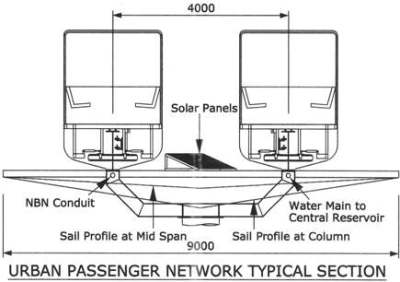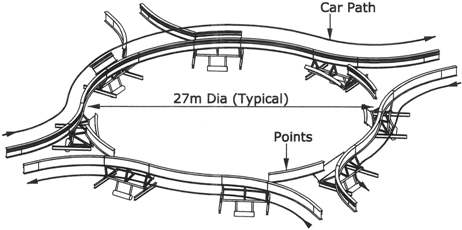Track Construction:-

The track concept is based on the use of 900WB 175 welded beams for urban tracks and 1200WB 314 for rural
tracks. These are commercially available beams manufactured using steel plates and a continuous welding machine.
They will be fabricated in a specially built factory in a suitable location for each network.
After fabrication, they will be transported along the newly constructed MonoCab VRT track for erection. This
will significantly reduce construction costs and disruption to traffic.

These beams are commercially available.
The WB900 175 beam weighs 175 kg/m and will be used in the urban tracks. Current retail cost is $426.00/m.
The WB1200 314 beam weighs 314 kg/m and will be used in rural tracks and tracks that will carry freight.
Current retail cost is $846.00/m.
The tracks will ALWAYS be constructed above flood level as shown below. Note how the heights of the
columns vary to achieve the best, most comfortable track alignment and keep the track above flood level.

Snow falls will not interrupt service. The 400 mm wide top flange is over 6.0 metres above
ground. The cars will disperse the snow as they pass.
Arterial Roads:-

The columns will be 900-1200 mm diameter steel erected on suitable foundations at approximately 30 metre (100
feet) centres in the medians as shown on the right.
As a general rule there are few services in the medians, hence minimal changes to existing infrastructure will
be required with the resultant cost and time benefits.
Overhead power lines and street lights will normally be the only services effected. The minimum clearance under
the track will be 5.0 metres with a minimum of 6.0 metres at existing intersections to guard against impact from
high loads.
Roads with No Medians:-

Where there is no median, the track can be erected as shown on the left where it passes through an existing
shopping precinct.
Arterial Road with Optional Walkway:-

By raising the tracks, a walkway/cycleway can be suspended underneath.
Rural Tracks:-

This configuration is similar to the urban track but has larger rails to cater for the heavier loads of freight
transport. The rails are also further apart to reduce buffeting when two vehicles pass each other going in the
opposite direction. The effective closing speed is 400 km/h (200 km/h each way).
 Points:- Points:-
At each station/stop, this points system allows a car to be taken off the main line and not impede through
traffic. Cars either side of the car stopping will have their speed varied to allow sufficient time for this
operation. As a general rule, it will only be at these locations that any land acquisition/resumption may be
required for car parking with cost and time benefits.
Urban Intersections:-

This is the configuration of a typical track intersection. It uses a slightly modified version of the points
above to divert vehicles onto other tracks.
Rural Intersections:-
In locations where there is significantly higher traffic in one direction, the track configuration would be as
below. The most usual location would be on a highway but may also be utilised on highly trafficked arterial
roads. This allows the traffic on the main MonoCab “highway” to pass this intersection without interruption
and reducing speed.

Computer Integrated Manufacturing:-
The manufacture of the tracks will be enhanced by the adoption the "CIM Steel" system (Computer Integrated
Manufacturing) that has been recently developed and adopted in Europe. In this process, the geometry of the steel
is developed and structurally analysed in the engineer's office. The final design data is then transmitted
electronically directly to the fabrication shop for fast, computerised, "just in time" manufacture and immediate
delivery to the site. This process will give significant time and cost benefits.
| 
